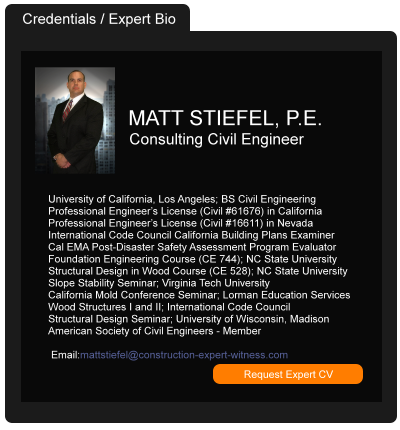Hirer Liable for Injury to Subcontractor’s Employee Due to Failure to Act, Not Just Affirmative Acts, Holds Court of Appeal
December 11, 2018 —
Garret Murai - California Construction Law BlogThe Privette doctrine, named after the court case Privette v. Superior Court (1993) 5 Cal.4th 689, provides that a higher-tiered party such as an owner or general contractor is not liable for injuries sustained by employees of a lower-tiered party such as a subcontractor on a construction project. There are, however, exceptions to the Privette doctrine. One of these exceptions is known as the “retained control doctrine.”
Under the retained control doctrine, a higher-tiered party cannot avoid liability under the Privette doctrine if the higher-tiered party: (1) retains control over the conditions of the work; (2) negligently exercises control over such conditions; and (3) its negligent exercise of control contributes to the injuries sustained by the employee of the lower-tiered party.
Read the court decisionRead the full story...Reprinted courtesy of
Garret Murai, Wendel, Rosen, Black & Dean LLPMr. Murai may be contacted at
gmurai@wendel.com
Is the Construction Industry Actually a Technology Hotbed?
August 19, 2024 —
Andrew Silver - Construction ExecutiveTechnology has always been a driving force behind progress, and the construction industry is no exception. Over the years, technological advancements have revolutionized the way companies design, plan and build structures, leading to increased efficiency, safety and sustainability. From virtual-reality simulations to drones and 3D printing, technology has transformed every aspect of the construction process. However, the construction trades still lag behind other sectors in adoption of digital technologies. With a lack of skilled labor continuing to be an impediment to growth and profitability in the construction industry, technological developments could have significant implications for successful adopters.
Already, the industry is seeing a huge difference in valuation between traditional engineering and construction firms and construction software companies. As labor shortages continue to hinder growth in the industry, consolidation is likely, as is the probability that companies with the greatest tech capabilities will be the most highly valued. There are several areas of technology that are of the greatest interest in the current marketplace.
BIM
Building information modeling with computer-aided design software now allows architects and engineers to create detailed and accurate 3D models of buildings and infrastructure projects, integrating data about every aspect of the building, from materials and costs to energy efficiency and maintenance schedules. These models not only help in visualizing the final product; they also enable better communication and collaboration among project stakeholders.
Reprinted courtesy of
Andrew Silver, Construction Executive, a publication of Associated Builders and Contractors. All rights reserved.
Read the court decisionRead the full story...Reprinted courtesy of
Real Estate & Construction News Round-Up (08/10/22)
August 29, 2022 —
Pillsbury's Construction & Real Estate Law Team - Gravel2Gavel Construction & Real Estate Law BlogThe Senate passes the Inflation Reduction Act, construction costs continue to rise across the U.S., commercial real estate advances the adoption of ESG strategies, and more.
- The recently-passed Inflation Reduction Act of 2022 leaves out the carried interest tax hike, much to the relief of real estate investors worldwide. (Taylor Driscoll, Bisnow)
- Commercial real estate continues to push forward ESG strategies, given the significant carbon footprints left by most office buildings. (Ted Jackson, CFO)
- “Space as a Service” tech company Neighbor, which re-purposes under-utilized real estate into storage for tenants, hits its stride in the post-pandemic landscape as the excess of unprofitable space rises. (The Real Deal)
Read the court decisionRead the full story...Reprinted courtesy of
Pillsbury's Construction & Real Estate Law Team
You’ve Been Suspended – Were You Ready?
April 20, 2020 —
Curtis W. Martin, Patrick J. Greene, Jr. & Levi W. Barrett - Peckar & Abramson“Effective tomorrow … the City is suspending all regular activity at construction sites in Boston.” This was just one of the surprises that greeted contractors last week. Contractors and owners with projects across the country are scrambling to comply with mandated governmental suspensions. Project participants should begin contingency planning for possible project shutdowns.
Reacting to Suspension
Your legal rights and remedies will be largely determined by your contract and the laws applicable to it. But some basic principles will be applicable depending on the source of the suspension.
Suspension by the Owner: An owner work suspension suggests review of the contract’s suspension of work clause. Federal contractors would look to the FAR Suspension of Work clause, FAR 52.242-14, but that is applicable if the suspension is by the Contracting Officer; the US would argue that a systemic suspension was a sovereign act and outside the FAR clause.
Contractors for private work and state or municipal work may have contractual suspension of work clauses. At least some suspension clauses provide relief for time and money.
Reprinted courtesy of Peckar & Abramson attorneys
Curtis W. Martin,
Patrick J. Greene and
Levi W. Barrett
Mr. Martin may be contacted at cmartin@pecklaw.com
Mr. Greene may be contacted at pgreene@pecklaw.com
Mr. Barrett may be contacted at lbarrett@pecklaw.com
Read the court decisionRead the full story...Reprinted courtesy of
Supreme Court Opens Door for Challenges to Older Federal Regulations
August 05, 2024 —
Jane C. Luxton - Lewis BrisboisWashington, D.C. (July 1, 2024) – On July 1, 2024, the U.S. Supreme Court issued another end-of-term major decision limiting the scope of federal agency actions in Corner Post, Inc. v. Board of Governors of the Federal Reserve System. Adding to the tectonic shift in the regulatory landscape created by the Court’s June 27 and 28 rulings constraining the role of administrative law judges and overturning longstanding “Chevron deference” by courts to federal agency expertise, the decision in Corner Post establishes a newly expanded time frame for affected entities to challenge final agency action. Instead of confirming that final agency action is subject to a default six-year statute of limitations, the Court held that under the Administrative Procedure Act (APA), the time limit for appeal begins to run when a plaintiff is injured by the agency's action, not when the action becomes final. This decision has important implications for businesses and others affected by federal regulations.
The case arose when Corner Post, a truck stop and convenience store in North Dakota that opened in 2018, challenged a 2011 Federal Reserve Board regulation (Regulation II) that set maximum interchange fees for debit card transactions. Corner Post filed suit in 2021, arguing that Regulation II allowed higher fees than permitted by statute. The lower courts dismissed the suit as time-barred under 28 U.S.C. § 2401(a), which effectively requires APA claims to be filed "within six years after the right of action first accrues."
Read the court decisionRead the full story...Reprinted courtesy of
Jane C. Luxton, Lewis BrisboisMs. Luxton may be contacted at
Jane.Luxton@lewisbrisbois.com
Construction Needs Collaborative Planning
January 20, 2020 —
Aarni Heiskanen - AEC BusinessWhat makes construction different from manufacturing is its dynamic nature. Unlike a systemized production plant, a construction site is a mesh of interconnected processes that are far from optimized. The traditional top-down planning practice does not solve problems on the construction site, as recent research reveals. Making planning collaborative is a necessary step in making construction less wasteful.
Everybody in the industry has felt frustration with inefficiencies in construction, but seeing the data is still disconcerting. I’ve had the pleasure of attending several workshops organized by the Finnish Aalto University’s research teams. These eye-opening events both revealed how much waste we have in construction today and suggested solutions to this problem.
Four Aalto University graduate students shared insights from their research at a workshop of the Waste Workgroup of the Building 2030 consortium. They focused on projects where takt production, a lean construction method, had been used. Takt production breaks the work down into equally timed work batches and typically shortens project lead time considerably—up to 50%. However, even these well-planned projects included waste and unnecessary movement, as the researchers found out.
Read the court decisionRead the full story...Reprinted courtesy of
Aarni Heiskanen, AEC BusinessMr. Heiskanen may be contacted at
aec-business@aepartners.fi
Trump Administration Issues Proposed 'Waters of the U.S.' Rule
December 19, 2018 —
Pam Radtke Russell - Engineering News-RecordConstruction contractors said a proposed revised definition of “Waters of the United States,” released by the Environmental Protection Agency and the Army Corps of Engineers on Dec. 11, would provide their firms with clarity about what types of permits they will need for their construction projects near various bodies of water.
Read the court decisionRead the full story...Reprinted courtesy of
Pam Radtke Russell, ENRMs. Russell may be contacted at
Russellp@bnpmedia.com
Domingo Tan Receives Prestigious Ollie Award: Excellence in Construction Defect Community
May 28, 2024 —
Wood Smith Henning & Berman(Anaheim, CA.) - Wood Smith Henning & Berman is thrilled to announce that
Domingo Tan, a partner in the Los Angeles office, has been awarded the prestigious Jerrold S. Oliver Award of Excellence. Fondly known as the "Ollie", this esteemed accolade is presented annually to a standout professional in the construction defect community who has demonstrated exceptional contributions and unwavering dedication to the field.
The exciting announcement of Tan's victory took place during the 30th Anniversary of the West Coast Casualty Construction Defect Seminar in Anaheim. Widely recognized as the nation's largest conference for professionals handling construction defect matters, the event drew a remarkable gathering of general counsel, risk managers, claim professionals, and attorneys who actively participated in the nomination and voting process.
The Ollie award pays tribute to the late Judge Jerrold S. Oliver, a highly respected legal professional renowned for his groundbreaking work in alternate dispute resolution methods for construction defect disputes. It celebrates individuals who embody the values of loyalty, commitment, and trust within the industry.
Read the court decisionRead the full story...Reprinted courtesy of
Wood Smith Henning & Berman


































































